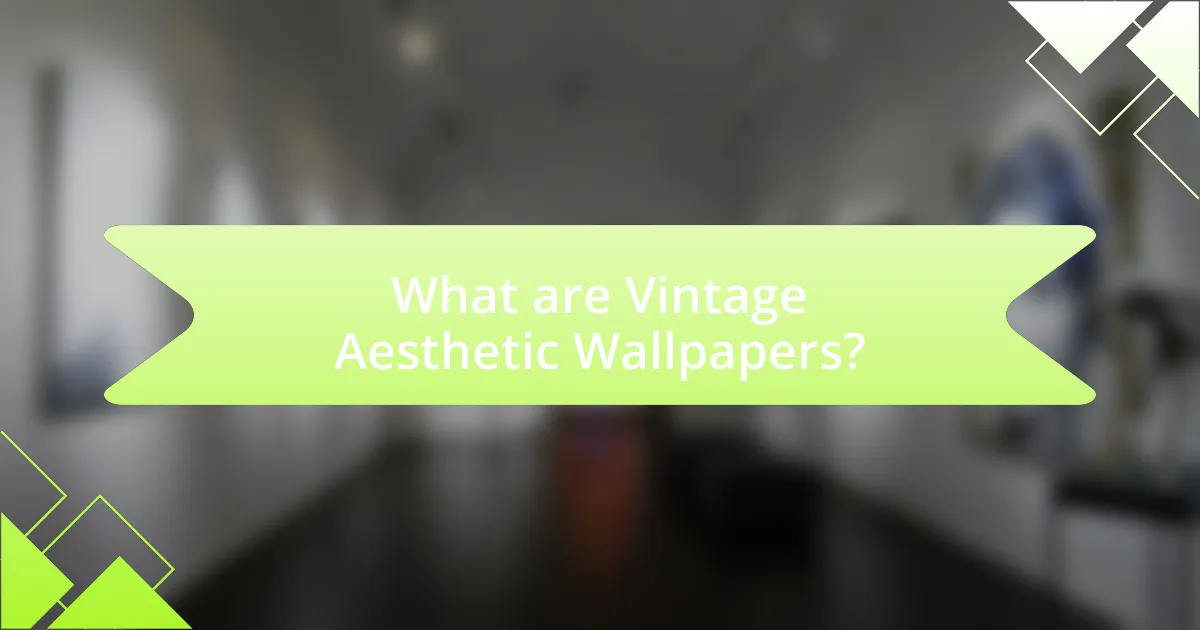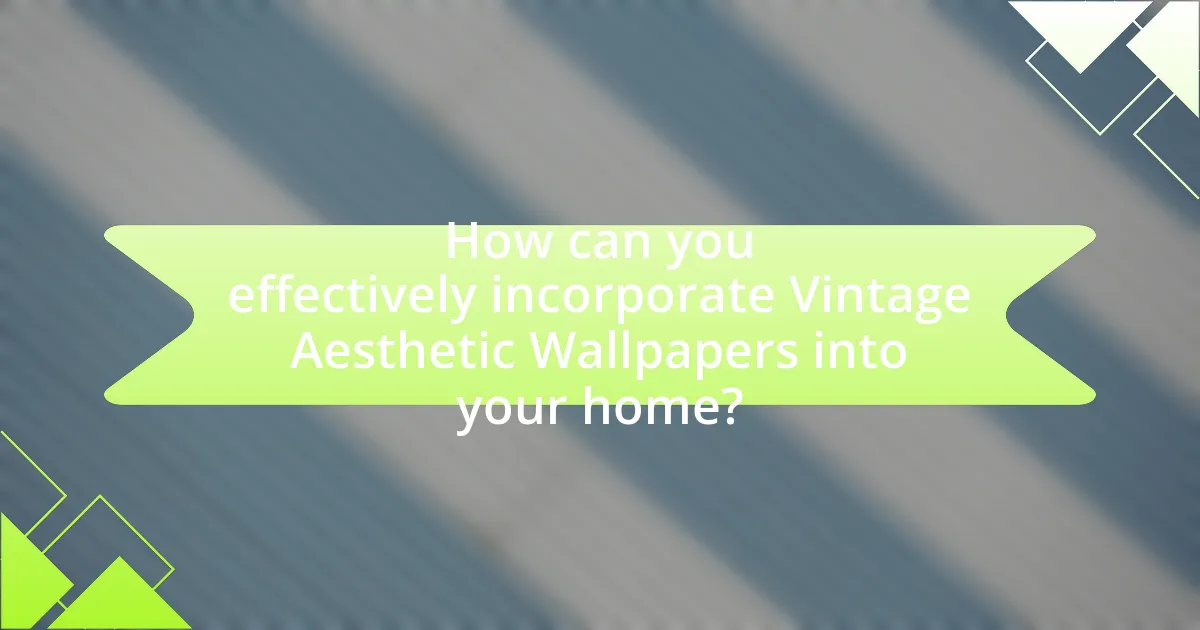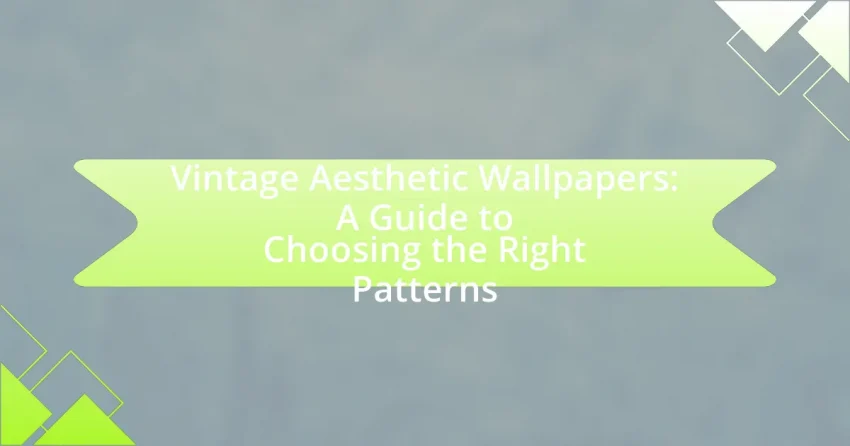Vintage aesthetic wallpapers are decorative wall coverings that draw inspiration from historical artistic styles, particularly from the late 19th to mid-20th centuries. This article explores the characteristics that define these wallpapers, including their intricate patterns, muted color palettes, and nostalgic appeal. It also examines the differences between vintage and modern designs, the historical influences shaping vintage aesthetics, and the factors contributing to their current popularity. Additionally, practical tips for selecting and incorporating vintage wallpapers into home decor are provided, along with insights on color schemes, patterns, and maintenance considerations to ensure a cohesive and inviting interior design.

What are Vintage Aesthetic Wallpapers?
Vintage aesthetic wallpapers are decorative wall coverings that evoke a sense of nostalgia through designs inspired by past artistic styles, particularly from the late 19th to mid-20th centuries. These wallpapers often feature floral patterns, intricate motifs, and muted color palettes that reflect historical design trends. The appeal of vintage aesthetic wallpapers lies in their ability to create a warm, inviting atmosphere while showcasing unique artistic expressions from different eras, such as Art Deco or Victorian styles.
How do Vintage Aesthetic Wallpapers differ from modern designs?
Vintage aesthetic wallpapers differ from modern designs primarily in their color palettes, patterns, and textures. Vintage wallpapers often feature muted, earthy tones and intricate, ornate patterns inspired by historical styles, such as Art Deco or Victorian, which evoke nostalgia and a sense of history. In contrast, modern designs typically embrace bold colors, minimalistic patterns, and clean lines, reflecting contemporary tastes and a focus on simplicity. The historical context of vintage wallpapers, often produced in limited runs and with traditional printing techniques, adds to their unique character, while modern wallpapers benefit from advanced printing technology and a wider variety of materials, allowing for more versatility and ease of application.
What historical influences shape Vintage Aesthetic Wallpapers?
Vintage aesthetic wallpapers are shaped by historical influences such as the Arts and Crafts Movement, Art Nouveau, and mid-20th century design trends. The Arts and Crafts Movement, which emerged in the late 19th century, emphasized handcrafted quality and natural motifs, leading to wallpapers featuring floral and organic patterns. Art Nouveau, popular from the 1890s to the early 1900s, introduced flowing lines and intricate designs, influencing wallpaper aesthetics with its emphasis on nature and elegance. Additionally, mid-20th century design trends, particularly the retro styles of the 1950s and 1960s, brought bold colors and geometric patterns, further diversifying the vintage aesthetic. These historical movements collectively contribute to the rich tapestry of vintage wallpaper designs, reflecting cultural values and artistic expressions of their respective eras.
What characteristics define Vintage Aesthetic Wallpapers?
Vintage aesthetic wallpapers are characterized by their nostalgic designs, muted color palettes, and intricate patterns that evoke a sense of history and charm. These wallpapers often feature floral motifs, damask patterns, and retro graphics that reflect styles from the late 19th to mid-20th centuries. The use of soft, faded colors and textures mimics the appearance of aged materials, enhancing their vintage appeal. Additionally, vintage aesthetic wallpapers may incorporate elements like distressed finishes or hand-drawn illustrations, further emphasizing their artisanal quality and connection to past design trends.
Why are Vintage Aesthetic Wallpapers popular today?
Vintage aesthetic wallpapers are popular today due to their nostalgic appeal and ability to evoke a sense of warmth and comfort in interior design. This trend is driven by a growing desire for personalization in home decor, as individuals seek to create unique spaces that reflect their personality and style. The resurgence of vintage aesthetics aligns with the broader cultural movement towards sustainability and the appreciation of craftsmanship, as many vintage wallpapers are made from high-quality materials and feature intricate designs that are not commonly found in modern alternatives. Additionally, social media platforms, particularly Instagram and Pinterest, have amplified the visibility of vintage aesthetics, inspiring a new generation to incorporate these styles into their homes.
What trends contribute to the resurgence of Vintage Aesthetic Wallpapers?
The resurgence of Vintage Aesthetic Wallpapers is primarily driven by a growing consumer preference for nostalgia and authenticity in home decor. This trend is evidenced by the increasing popularity of retro design elements in contemporary interiors, as consumers seek to create warm, inviting spaces that reflect personal history and character. Additionally, social media platforms, particularly Instagram and Pinterest, have amplified the visibility of vintage styles, showcasing how these wallpapers can enhance aesthetic appeal in modern homes. The rise of sustainable and eco-friendly practices also plays a role, as many vintage wallpapers are made from natural materials, appealing to environmentally conscious consumers.
How do Vintage Aesthetic Wallpapers enhance interior design?
Vintage aesthetic wallpapers enhance interior design by adding character and a sense of nostalgia to spaces. These wallpapers often feature intricate patterns, muted colors, and historical motifs that evoke a specific era, creating a unique ambiance. For example, floral designs from the Victorian period or geometric patterns from the Art Deco movement can transform a room, making it feel more inviting and personalized. The use of vintage wallpapers can also serve as a focal point, drawing attention and sparking conversation, thereby enriching the overall aesthetic experience of the interior.

What factors should you consider when choosing Vintage Aesthetic Wallpapers?
When choosing Vintage Aesthetic Wallpapers, consider the design style, color palette, material quality, and compatibility with existing decor. The design style should reflect the specific vintage era you wish to emulate, such as Art Deco or Victorian, ensuring it aligns with your aesthetic goals. The color palette must harmonize with your room’s overall theme, as vintage wallpapers often feature muted tones or bold patterns characteristic of their time. Material quality is crucial for durability and ease of application; options like vinyl or paper can vary significantly in texture and longevity. Lastly, ensure the wallpaper complements your existing decor elements, such as furniture and accessories, to create a cohesive look.
How do you determine the right color palette for Vintage Aesthetic Wallpapers?
To determine the right color palette for Vintage Aesthetic Wallpapers, analyze historical color trends and the emotional impact of colors used in vintage designs. Vintage aesthetics often draw from specific eras, such as the muted tones of the 1970s or the pastel shades of the 1950s, which can guide the selection process. For instance, research shows that colors like dusty rose, sage green, and soft yellows were prevalent in vintage wallpaper designs, reflecting the preferences of those times. By referencing color theory and historical context, one can create a palette that resonates with the vintage aesthetic while ensuring visual harmony and emotional appeal.
What color schemes are commonly found in Vintage Aesthetic Wallpapers?
Common color schemes found in Vintage Aesthetic Wallpapers include muted pastels, earthy tones, and rich jewel colors. These palettes often feature soft pinks, faded blues, and gentle greens, which evoke a nostalgic feel. Earthy tones like terracotta, mustard yellow, and olive green are also prevalent, reflecting natural elements. Additionally, jewel tones such as deep burgundy, emerald green, and navy blue add a touch of elegance. The use of these color schemes is rooted in historical design trends from the late 19th and early 20th centuries, where wallpapers aimed to create warm and inviting spaces.
How can color influence the mood of a room with Vintage Aesthetic Wallpapers?
Color significantly influences the mood of a room adorned with Vintage Aesthetic Wallpapers by evoking specific emotional responses. For instance, warm colors like reds and yellows can create a cozy and inviting atmosphere, while cooler colors such as blues and greens tend to promote calmness and relaxation. Research indicates that color psychology plays a crucial role in how individuals perceive their environment; for example, a study published in the journal “Color Research and Application” found that colors can affect mood and behavior, with certain hues linked to feelings of happiness or tranquility. Therefore, selecting the right color in Vintage Aesthetic Wallpapers can enhance the desired ambiance, making it essential to consider color choices carefully.
What patterns are most popular in Vintage Aesthetic Wallpapers?
Floral patterns are the most popular in Vintage Aesthetic Wallpapers. These designs often feature intricate, romantic motifs inspired by nature, reflecting styles from the Victorian and Art Nouveau periods. Additionally, damask and toile patterns are also favored, characterized by their ornate detailing and historical significance, which evoke a sense of nostalgia and elegance. The popularity of these patterns is supported by their frequent use in interior design, where they create a warm, inviting atmosphere reminiscent of past eras.
What are the key types of patterns used in Vintage Aesthetic Wallpapers?
The key types of patterns used in Vintage Aesthetic Wallpapers include floral designs, damask patterns, geometric shapes, and toile motifs. Floral designs often feature intricate, nature-inspired elements that evoke a sense of nostalgia, while damask patterns are characterized by their ornate, symmetrical designs that add elegance. Geometric shapes provide a more modern twist, often incorporating repeating patterns that create visual interest. Toile motifs typically depict pastoral scenes or landscapes, enhancing the vintage feel. These patterns are rooted in historical design trends, with floral and damask styles dating back to the 18th century, reflecting the aesthetic preferences of that era.
How do different patterns affect the overall aesthetic of a space?
Different patterns significantly influence the overall aesthetic of a space by creating visual interest, establishing mood, and defining style. For instance, geometric patterns can impart a modern and structured feel, while floral designs often evoke a sense of warmth and nostalgia. Research indicates that patterns can affect human emotions and perceptions; a study published in the Journal of Environmental Psychology found that spaces with varied patterns can enhance creativity and engagement. Therefore, the choice of patterns in wallpapers directly impacts how individuals experience and interact with their environment.

How can you effectively incorporate Vintage Aesthetic Wallpapers into your home?
To effectively incorporate Vintage Aesthetic Wallpapers into your home, select a focal wall in a room to apply the wallpaper, as this draws attention and creates a striking visual impact. Vintage wallpapers often feature intricate patterns and colors that can enhance the character of a space; for instance, floral or damask designs can evoke a sense of nostalgia and warmth. Additionally, consider pairing the wallpaper with complementary decor elements, such as vintage furniture or accessories, to create a cohesive aesthetic. Historical data shows that using wallpaper in a single accent area can make a room feel more inviting and stylish, as supported by interior design trends that emphasize the importance of statement walls.
What are the best rooms for using Vintage Aesthetic Wallpapers?
The best rooms for using Vintage Aesthetic Wallpapers are living rooms, bedrooms, and dining areas. Living rooms benefit from vintage wallpapers by creating a warm and inviting atmosphere, often enhanced by floral or damask patterns that evoke nostalgia. Bedrooms can utilize vintage designs to promote a cozy and serene environment, with soft colors and intricate motifs that encourage relaxation. Dining areas, when adorned with vintage wallpapers, can add character and charm, making meals more enjoyable in a space that feels both timeless and stylish. These rooms are ideal because vintage aesthetics often complement traditional and eclectic decor, enhancing the overall ambiance.
How can Vintage Aesthetic Wallpapers complement existing decor?
Vintage aesthetic wallpapers can enhance existing decor by adding a layer of character and nostalgia to a space. These wallpapers often feature intricate patterns and muted color palettes that evoke a sense of history, making them ideal for complementing both modern and traditional furnishings. For instance, a floral vintage wallpaper can harmonize with antique furniture, while geometric designs can provide a striking contrast to minimalist decor. The use of vintage wallpapers can also create a cohesive theme throughout a room, tying together various elements such as textiles, artwork, and furniture styles, thereby enriching the overall aesthetic.
What tips can help you choose the right wallpaper for each room?
To choose the right wallpaper for each room, consider the room’s purpose, size, and lighting. For example, in a small room, lighter colors and smaller patterns can create an illusion of space, while darker colors and larger patterns may overwhelm the area. Additionally, the wallpaper’s texture can affect the room’s ambiance; smooth finishes can lend a modern feel, while textured wallpapers can add warmth and depth. It’s also essential to coordinate the wallpaper with existing furniture and decor to ensure a cohesive look. According to interior design experts, selecting wallpaper that complements the room’s function enhances both aesthetics and comfort.
What are some common mistakes to avoid when selecting Vintage Aesthetic Wallpapers?
Common mistakes to avoid when selecting Vintage Aesthetic Wallpapers include choosing patterns that clash with existing decor, overlooking the scale of the design, and failing to consider the room’s lighting. Clashing patterns can create visual chaos, while the scale of the design must complement the size of the room; for instance, large patterns can overwhelm small spaces. Additionally, lighting affects how colors and patterns appear; a wallpaper that looks appealing in a store may not translate well in different lighting conditions, leading to dissatisfaction after installation.
How can you ensure that the wallpaper matches your personal style?
To ensure that the wallpaper matches your personal style, first identify your aesthetic preferences by considering colors, patterns, and themes that resonate with you. For instance, if you favor vintage aesthetics, look for wallpapers that feature classic motifs, muted color palettes, or retro designs that reflect historical styles. Research shows that individuals often feel more comfortable and satisfied in spaces that align with their personal tastes, as highlighted in studies on environmental psychology. By selecting wallpapers that embody your unique style, you create a cohesive and inviting atmosphere in your home.
What should you consider regarding wallpaper maintenance and durability?
When considering wallpaper maintenance and durability, it is essential to evaluate the material type, cleaning methods, and environmental factors. Different materials, such as vinyl or paper, have varying levels of durability; for instance, vinyl wallpaper is more resistant to moisture and easier to clean than paper wallpaper. Regular cleaning with appropriate solutions, like mild soap and water for washable wallpapers, helps maintain appearance and longevity. Additionally, factors such as humidity and sunlight exposure can affect wallpaper durability; high humidity may lead to peeling, while direct sunlight can cause fading. Therefore, selecting the right material and implementing proper care routines are crucial for ensuring the wallpaper’s longevity and aesthetic appeal.
What practical tips can help you choose the right Vintage Aesthetic Wallpapers?
To choose the right Vintage Aesthetic Wallpapers, first assess your existing decor to ensure the wallpaper complements your style. Vintage aesthetics often feature floral patterns, muted colors, and intricate designs, so select wallpapers that harmonize with your furniture and color palette. Additionally, consider the scale of the pattern; larger patterns can make a bold statement in spacious areas, while smaller patterns work well in intimate spaces.
Research indicates that color psychology plays a significant role in interior design; for instance, soft pastels can create a calming atmosphere, while vibrant hues can energize a room. Therefore, choose colors that evoke the desired mood in your space. Lastly, sample the wallpaper in your environment before making a final decision, as lighting can significantly alter the appearance of colors and patterns.
